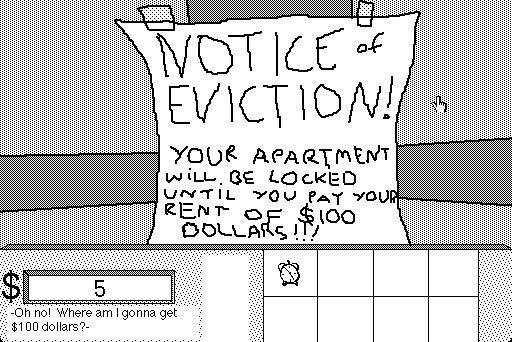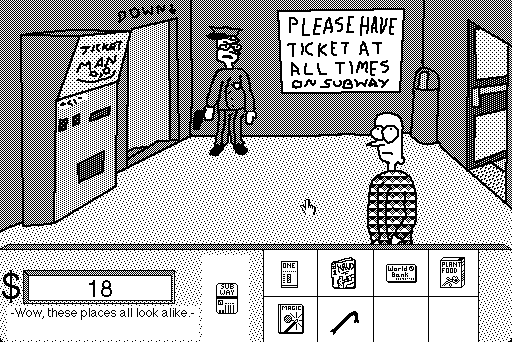HyperCard Adventures
In the 1980s and 1990s, if you had a Macintosh and HyperCard, you could make a point & click adventure game. It was as simple as that.
Using a mouse, you could draw crude, 1-bit graphics in the same style as MacPaint. It was a ball mouse[1], of course, and you’d fight against it every step of the way. These pictures had a cartoonish charm to them, the same kind of charm as your high school friend’s comic book that she published with a Xerox machine and some glue.
HyperCard provides a simple programming language called HyperTalk, designed to look suspiciously like English. With HyperTalk, you can attach script to your drawings that sent the player to different “cards”, played sounds, or manipulated the game state. A script on a card might look like this:
on mouseUp
global key
if key = 1 then
play "DoorOpen"
go to card 75
else
play "DoorShake"
put "It’s locked" into card field speech
end if
end mouseUpThis is enough to make simple puzzles out of global state and inventory items. From a tech standpoint, that’s all you need, right? Here are two adventure games made in HyperCard.
The Adventures of Sean Part 2
The game is simple, short, and charming.
From the Read Me:
The Adventures of Sean is an interactive comic book in which you play the role of Sean, a character loosely based on a friend of mine that seems to find trouble more easily than others.
[…]
The Adventures of Sean contains scenes of cute cartoon characters getting hurt. If you do not appreciate the sight of cartoon blood, please do not play this game. You have been warned.
Right off the bat, you’re presented with a simple problem: your alarm clock is ringing, and you want it to stop. You have to fumble about in the dark to turn the light on, and the only way to turn your alarm clock results in the untimely death of an innocent bystander outside your apartment.

Your goal is to somehow get away with this, without getting shot by the cops or stabbed by a crook on the wrong side of town. You’ll need to pick up some resources along the way, like cash, a bulletproof vest, and a nuclear bomb.
The artwork exaggerates the cartoonish MacPaint / HyperCard style by picking a super chunky, 8 pixel brush for the outlines.

Dave Grossman, veteran adventure game designer for LucasArts and Telltale games, described The Adventures of Sean as his favorite adventure game of all time (other than those he worked on) in a 2009 interview,
My favorite answer to this question is “The Adventures of Sean II,” a game most people have never heard of. My fondness for it has nothing to do with actual quality—quite the opposite, I’d say. It was written (and drawn) in Hypercard on a Mac about a million years ago, and the fact that it looks like a series of child’s crayon drawings merely serves to show that an adventure game does not need art or flashy special effects in order to be fun. It has some clever puzzles and a simple, entertaining story, and stands out for me as a bare-bones example that those are the core of an adventure game experience, and in the end they’re all you really need.
Links
- Macintosh Repository: Adventures of Sean (requires HyperCard)
- Macintosh Garden: Adventures of Sean (requires HyperCard)
- Internet Archive: Adventures of Sean (playable in browser)
Walkthrough
- Click around and turn on the light.
- Pick up the alarm clock, go to the window, go into your inventory, click the alarm clock to throw it out.
- Get dressed.
- Go outside and get the woman’s keys.
- Go back inside, and enter apartment #4.
- Get cash out of the oven. (Don’t turn the oven on first.)
- Get the brick from the bathroom (click on it until you get it).
- Outisde, get in the car and drive to the hotel. (Don’t drive farther, the cops will shoot you.)
- Pay for a room.
- Go inside your room, lock the door, and turn the light out. (If you don’t lock your door first, the cops will shoot you.)
- Turn on the TV, and wait for a commercial for 555-VITO.
- Call Vito on the phone, and give a name other than “Sean”. (If you say “Sean”, he refuses.)
- Drive downtown, and meet Vito in the alley. (Don’t come back until later, Vito’s henchman will kill you.)
- Buy the skeleton key from Happy Hank’s Semi-Automatics.
- In front of the bank, use the skeleton key.
- Go back to the hotel room and call Vito again.
- In the alley, use the brick.
- Go in through the window and take the money.
- Go back to Happy Hank’s and buy the hammer, bulletproof vest, and H bomb.
- In the alley, click on the trash can until it asks you to throw something away. Throw away the “bomb”.
- Use the vest.
- Walk through the alley to the other side of town. (Without wearing the vest, you get killed by the crook.)
- Go into the house and use the hammer.
- Click on the crook’s face to get his mask.
- Put the mask on. (If you don’t, a tank will show up and blow your head off once you step out.)
- Outside, head left to the airport.
- Donate “hammer”, “key”, and “vest” to the man with the flower.
- Go inside, walk up to the ticket counter, and ring the bell.
- Back at the hotel, call to make an airplane reservation on the phone.
- At the airport, take the ticket from the counter and get on the plane. (If you didn’t throw the bomb away in the trash can, the plane turns around and you are shot.)
Get Rich Quick
Gen X media brought us stories of mediocre heroes, who want to escape from the grind, escape from the rat race, but still have to face the indignity of earning a living.
It’s called “Get Rich Quick” because you have to figure out how to make $100 right now or you’ll be locked out of your apartment. Get Rich Quick was made by PRISIM Software, a.k.a. Andrew Griffin & Andrew Raines. According to its page on the Internet Archive, it was made in 1996.

The PRISM Software web page was hosted on GeoCities of course. GeoCities got taken down in 2009, but you can still find the website in various archives (OoCities, Wayback Machine snapshot taken Sept 07, 2009).
This is an ambitious project. There are several locations nearby the three stops on the game’s subway line, and tons of different ways to make some quick cash—or lose it.
Like Adventures of Sean, you start out being woken up by your alarm clock, which is the first inventory item you encounter. Unlike Adventures of Sean, you can’t lose this game, but you can get stuck (soft locked, unable to make progress). You can end the game any time once you have $100, and you get an alternate ending if you manage to make $160, which is the maximum.

Links
Walkthrough
Apartment
$5 cash.
- Grab the alarm clock.
- Use the vacuum cleaner to get a key from under the fridge which unlocks a lockbox in your closet with $y.
Blue Station
$40 cash, $30 expenses.
- In an alleyway, grab the comic book from the trash can.
- Don’t play the shell game.
- Get the card from the ATM.
- Pawn the alarm clock for $10.
- Get a package to deliver from the post office.
- Get the crowbar for $10.
- Use the crowbar in the former casino front room to get $30.
- Buy a subway ticket for $20. Remember to take it out of the machine!
Green Station
$25 cash, $17 expenses.
- Take $5 from the trash in the subway entrance.
- Buy a theater ticket for $7, and popcorn for $5.
- Don’t play the jackpot arcade game, it’s broken.
- Get the magic book from the store for $5.
- Give the comic book to the store clerk.
- Go upstairs and use the crowbar on the safe to get books.
- Give the books to the store clerk for $20 and get your comic back.
Red Station
$10 cash.
- Get $5 from the belly button of the cop at the subway entrance.
- Get $5 from the trash bag next to the vine to the left of the dump.
- Knock on the trailer door and deliver the package.
- Take the screwdriver.
- At the farthest left, get the plant food.
- Use the plant food on the vine to the left of the dump.
- Climb over the vine and enter the dump.
- Use the crowbar on the locker to get the board and metal rod.
Green Station Again
$5 cash.
- Put the board under the tree and climb up.
- Get $5 from the hole in the tree.
- Use the rod to knock the bone down; get the bone.
Blue Station Again
$122 cash.
- Return to the post office for $15 payment.
- Give the popcorn and comic book to the comic shop for $30.
- Click on the shell game, and then use your magic book to explain how the hustler is cheating, and get $20.
- Go to the apartment, use the ATM card to open the door to apartment #2.
- Use the bone to distract the dog.
- Get the beer from the kitchen counter.
- Go to the alley and give the beer to the homeless man.
- Take $7 from the homeless man’s can.
- Go to the back of the casino.
- Use the metal rod to descend.
- Use the screwdriver to open the panel and spread dust everywhere.
- Look at the keypad, and press all of the dust-covered buttons. You should end up with the number 88.
- Go through the door, open the panel, and get $50.
This will leave you with $160. You can talk to your landlord once you have $100. With $160, you get a secret ending.
My Own Games
I made my own games in HyperCard, too. They were much a bit simpler and shorter than the games above, and generally speaking, they were never finished (with one or two exceptions).
Fort Dirklefat was the only game I remember ever finishing, and I made it together with my friend Michael H. It was little more than a series of obstacles strung together, none of which required any special effort to solve (we were quite young when we made it). Since the game was a “success” (by which I mean it was complete), we began work on a sequel, and even made a live-action video adaptation of the first game.
I did start a much more ambitious HyperCard game called “Marty’s Adventures”, which had an inventory system, but didn’t get very far.
Making Your Own Game Today
At /dev/world 2018, Josh Deprez presented Making a Visual Novel in HyperCard (YouTube recording). He talks about making a HyperCard game in 2018 using Mini vMac. You can play his game online at hypercardadventures.com.
There is also a HyperCard tag on itch.io. Not all games are tagged correctly, but there are probably 20 genuine HyperCard games listed.
Corrections
A previous version of this article omitted Andrew Raines as part of PRISIM Software. Oops!
Footnotes
- Optical mice were sometimes found on expensive Unix workstations, but not in the hands of mortals. I remember using an optical mouse on a Sun workstation in the 1990s. The details are fuzzy, but from digging around, it looks like you could have bought a Sun UltraSPARC workstation for around $5,000 (USD). ↩